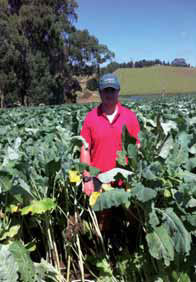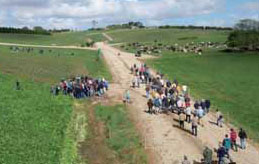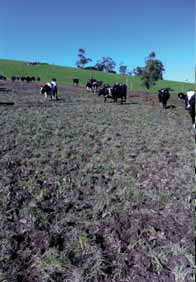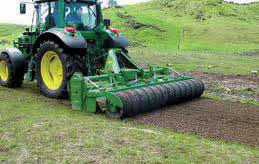Managing pasture recovery from pugging
High rainfall can cause soils to become saturated which can lead to severe pasture damage. Recovery will depend on a number of factors.

Assessing equipment and management options according to severity of pasture damage

Firstly, assess the severity of the pasture damage. Options available based on severity are:
Light:
- may have a number of options, from rolling when soil conditions are drying — this option is generally only available during a small window of time and on flatter type land.
Medium:
- rolling or smudging, may look at over-sowing if plant density has been affected.
Heavy or severe:
- may require pasture re-sowing or a complete renovation using either a crop grown for silage, hay or summer crop.
Very severe:
(often paddocks that may have been sacrificed or severely wet during rotational grazing)
- will need to be cropped or could go back to permanent pasture if clean of annual weed or can control spring germinating weeds (fat hen, wireweed, stinging nettle, deadly nightshade).

Renovation aims
As soon as soils begin to dry out, there are a number of options.
Can I roll the soils of my farm? (Roll on the 2 to 3 days that you can so have the roller prepared.)
If yes, this can often be the answer for light to medium pugging on farms that are not too steep. Soils need to be sufficiently dry to hold the tractor (duel tyres may help if possible) and the roller has the effect of levelling the soil profile.
The improvement can be seen by filling the pug marks, which are now not getting so wet, therefore distributing moisture more evenly and improving pasture growth.
The same timings apply for both harrowing and smudging. Topping up with pasture seed can be done after these jobs take place, but if they are severely pugged the seed may not germinate due to lack of seed soil contact.
Roll, smudge or harrow as soon as soil is firm enough to drive on.
Areas to target
This is open to debate. One of the main points is to try and be organised to get the job done at the appropriate time and in an efficient manner. Target the most damaged areas first — generally these could be the summer crop targets.
Ideally, don't plant plant any more than 10 to 15 per cent of your farm into summer crops as it can become difficult to feed large amounts of summer crops to the cows. One exception is chicory as this can be a grazing crop for an 18 month period.
If there are still further heavy, severe or very severe pugged areas, direct drilling is not an option using a power harrow. Re-sowing to ryegrass in September can be achieved on some farms.
In many cases the area may be too large to renovate this spring. These areas could be identified for autumn renovation. In the meantime levelling over the late spring and summer period could be used as a sacrifice area.
Key points
- Prioritise your main targets early if possible.
- Control of weeds and pests essential both pre and post grazings.
- Always check plant back periods from earlier chemical usage.
- All resowing requires appropriate timing.
- Don't take on more than you can manage effectively.
- All resowing requires good seed soil contact (good tilth) — rolling to maximise establishment.
- Rolling after harrowing generally optimises germination.
- If harrowed after sowing and rain is predicted, rolling may not be required.
- Rolling is beneficial in most soil types to increase seed soil contact.
- Rolling may not help if soils are prone to glazing (generally associated with clay soils), or in some soil types where the seed bed has become very powdery.

Planting times
Ryegrass would generally need to be planted by the end of September, planting either Italians or Perennials. This seed needs to be covered by harrowing if the clumps are not too large, and if so, go over with power harrows twice. A follow-up rolling of both techniques would be beneficial.
Note: If annual ryegrasses are sown, they will not grow through the summer period and will seed during the summer.
Spring crops have different planting times, but most crops benefit from planting followed by harrowing and rolling.
Table 1 shows a general time frame for planting and grazing.
| Ideal planting and grazing dates | September to October | November | December | January | February | March |
|---|---|---|---|---|---|---|
Species | Brassicas | Brassicas | ||||
Graze | Ryegrass | Ryegrass | Ryegrass | Brassicas | Brassicas | Chicory |
| Harvest | Chicory | Sorghum | Sorghum | Maize |
All of these crops would benefit from some irrigation or effluent. Brassia planted in December in most areas would need to be irrigated.
Table 2 shows a time frame for planting based on the reliability for grazing or harvest.
| Crop reliability - to supply feed for grazing or harvest reliability | December | January | February | March |
|---|---|---|---|---|
High | Turnip | Turnip | Sorghum | Maize |
Medium | Millet | Turnip | Pasja | |
Low | Turnip |
- Pasja and turnip can be highly reliable with irrigation applied.
- Turnip does not grow well under flood irrigation.
- Millet can be direct drilled into soils without root mat but heavy sowing rates will be required.
Tips common to all crops
- High germination rate of seeds, 90 per cent plus — a must.
- Spring ryegrass should be sown at 30 per cent higher rates than autumn.
- Have an excellent cultivated seed bed and control weeds.
- Soil clump size generally smaller than 50mm.
- Address any acidity problems apply complete NPKS before planting, top up fertiliser after germination.
- Good seed soil contact — a must.
- Monitor for pests and take action if problems occur.
- Introduce stock slowly to enable their rumens to adapt.
Table 3 shows the best cultivars or mixes with appropriate sowing rates
| Cultivar best bets seed or mix | Sowing rate (kg/ha) | Sowing depth (cm) (must roll) | Net energy (MJ ME/ha) |
|---|---|---|---|
Brassica | Pasja and Rape 3 to 5 | 0.5cm or broadcast harrow | 91,000 |
| 8 to 10 | 0.5cm or broadcast harrow | 114,000 |
Brassica herb and Millet | 8 to 16 | Broadcast harrow and roll | 81,000 |
Sorghum | 20 to 25 | 5cm | 76,000 |
Maize | 80,000 to 100,000 | 5cm | 121,000 |
Yields are taken by Notman Seeds over a number of years throughout South and West Gippsland.
Acknowledgements
This information was originally written by Frank Mickan, Ellinbank.
July 2011.